
E-mail: font@focusonnature.com
Phone: Toll-free in USA 1-888-721-3555
or 302/529-1876
 |
PO Box 9021,
Wilmington, DE 19809, USA E-mail: font@focusonnature.com Phone: Toll-free in USA 1-888-721-3555 or 302/529-1876 |
HighlightS
FROM some PREVIOUS
FOCUS ON NATURE TOURS
in GUATEMALA
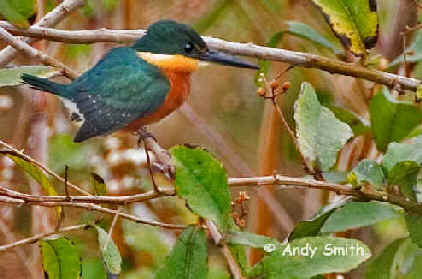
The American Pygmy Kingfisher
is often seen during FONT tours
in the Peten region of Guatemala.
The
tour summaries here are with the most-recent tours first.
For some tours there are links below for longer narratives. Also there are links
to UPCOMING TOUR ITINERARIES, and lists (some with photos) of BIRDS,
BUTTERFLIES, MAMMALS, and OTHER NATURE.
Previous
Tours:
April/May 2009 in the "Highlands & Lowlands"
December 2008 / January 2009, Holiday Tour in the "Highlands & Lowlands"
July 2007 in the "Highlands & Lowlands"
December 2006 / January 2007, Holiday Tour, in the "Highlands & Lowlands"
March 2006 in the "Highlands & Lowlands"
December 2005 / January 2006, Holiday Tour, in the "Highlands & Lowlands"
March/April 2005 in the "Highlands & Lowlands"
December 2003 / January 2004, Holiday Tour, in the "Highlands & Lowlands"
April 2002, in the "Highlands & Lowlands"
December
2001 / January 2002, Holiday Tour, in the "Highlands & Lowlands"
In the FONT
Archives:
Some Photos of People, Places, & More during Previous FONT Tours in
Guatemala
In all, there have been 16 FONT birding & nature tours in Guatemala.
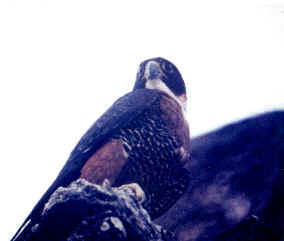
An Orange-breasted Falcon on a
Tikal temple.
That species has been seen there
during most FONT tours in Guatemala,
Links:
Cumulative
List of Birds during FONT Guatemala Tours
(with photos)
Upcoming
FONT Birding & Nature Tours in Guatemala
![]()
GUATEMALA - April/May 2009: in the "Highlands & Lowlands"
During this, the 16th FONT tour in Guatemala,
we visited both the highlands and lowlands of the country. We saw much,
in that picturesque and interesting land, including 16 species of hummingbirds,
and 280 species of birds in all.
Among them there were motmots, and manakins, orioles and oropendolas,
wrens and warblers, and tanagers, trogons, toucans, toucanets,
thrushes, and tityras.
Among the mammals, there were a couple beginning with the letter
"t": a tapir and a tayra.
Maybe most notable among our birds was a pair of very rare Azure-rumped
Tanagers. We saw them so very nicely!
Two other bird species were seen with "Azure" in their names:
both actually with the same adjective, the Azure-crowned Jay and the Azure-crowned
Hummingbird.
Among our smaller hummingbirds were the Black-crested Coquette and
the Emerald-chinned Hummingbird; among our larger ones, there were 3
species of Sabrewings: the Violet, Rufous, and Wedge-tailed.
Among our Woodcreepers, there was the Wedge-billed, while among
our Woodpeckers, there was the Pale-billed (rather like the
infamous, and now probably extinct, Ivory-billed Woodpecker of
North America - it's in the same genus.)
Among our Warblers, a good one indeed was the Pink-headed. We
viewed well that wonderful bird.
And among our many other birds also viewed well are 2 others deserving mention
here: Long-tailed Manakins as they performed on a forest branch, and a Leaftosser
doing just that, tossing leaves, on a forest floor, just a few feet from us!
As during our previous Guatemala tours, again we saw Orange-breasted Falcon
by a Mayan temple. We've always enjoyed our tours in Guatemala, and in April/May
2009 we did so again.
Links:
Lists of Birds & Other Wildlife during our Guatemala Tour - April/May 2009
![]()
GUATEMALA - December
2008 / January 2009: Our Annual Holiday Tour, in the "Highlands & Lowlands"
During this tour, our
15th in Guatemala, as many as 316 species of
birds were found throughout a country with a variety of habitats and some
most spectacular scenery. Highlights among the birds included: Pheasant
Cuckoos, Orange-breasted Falcons, and Ocellated Turkeys near the
Mayan ruins at Tikal, 5 species of
kingfishers during one river-boat ride in the Peten
in addition to Sungrebe and Boat-billed Herons, while in the
mountains our birds included: looks at both Ferruginous and Mountain
Pygmy-Owls, Chestnut-sided Shrike-Vireo, Blue-and-white Mockingbird,
Black-throated and Bushy-crested Jays, Hooded Grosbeak, Pink-headed
Warbler, and the dapper Prevost's Ground Sparrow.
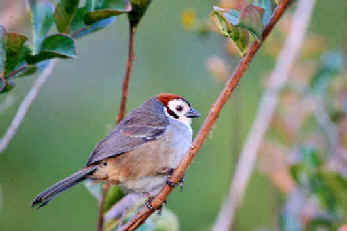
Prevost's Ground Sparrow
(photo by Marie Gardner)
And there were more
than birds, as would normally be the case during a tour in the Neotropics. But
what was not expected was to be another tour with ANOTHER JAGUAR,
following our previous tour a couple months earlier just to the north in
southern Mexico when that large, wild cat was also encountered. During the Dec
08/Jan 09 Guatemala tour, the Jaguar was at Tikal
at night, where it roamed just outside our rooms. The roar of the animal was
heard 3 times there during one of the nights of our stay.
Other animals during the tour included: both Yucatan Howler and Central
American Spider Monkeys, White-nosed Coatis, Central American Agoutis, and White-tailed
Deer. We saw all of them during the day not far from where the roaring Jaguar
wandered about at night.
In the mountains, in darkness before dawn, a sound that we heard was that of the
animal called the Cacomistle (a raccoon-like creature).
In darkness, after one fine day of our tour, we saw in the distance a red glow
in the sky and a red flow on the slope of a high volcano - another notable
experience during our week-plus Guatemala "festive, holiday tour".
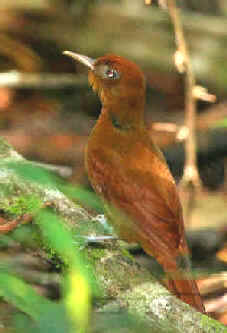
The Ruddy
Woodcreeper was one of over 300 species of birds
during our FONT Guatemala tour in Dec '08/Jan '09.
Photos of some others seen during the tour follow.
(above photo by
Marie Gardner)
Links:
Lists of Birds & Other Wildlife during our Guatemala Tour in December 2008 / January 2009
The following set of photos are just a few of the 317 species of birds that were
found during the FONT Holiday tour in Guatemala in Dec/Jan 2008-09. (These
photos by Dick Tipton.)
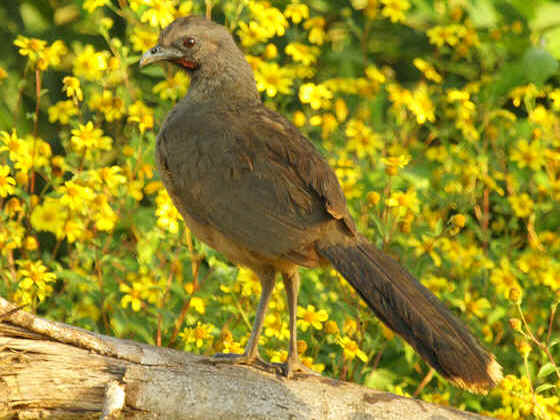
Plain Chachalaca
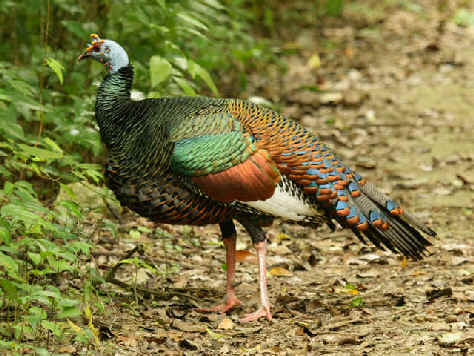
Ocellated Turkey
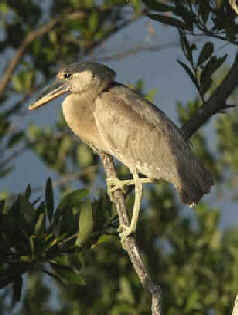
Boat-billed Heron

Squirrel Cuckoo
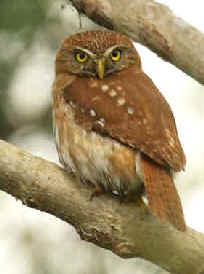
Ferruginous Pygmy-Owl
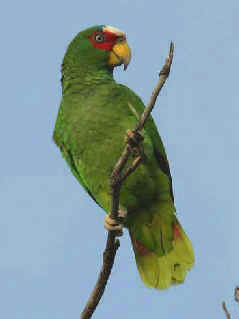
White-fronted Amazon
![]()
GUATEMALA - July 2007 in the "Highlands & Lowlands"
This was the 14th
FONT tour in Guatemala. Among its highlights were:
an Olive Ridley Sea Turtle hatchling that we watched on a beach as it
made its way into the surf of the ocean,
and then, the following day, seeing 2 spectacular Horned Guans! on
branches in trees just above us, in a mountain forest.
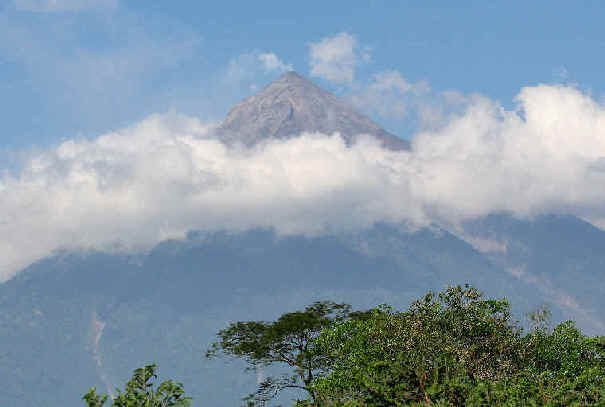
In the highlands of Guatemala,
there are numerous volcanoes,
and on one of them during our July 2007 Guatemala Tour,
we saw a very rare bird - the Horned Guan!
In the photo below, one of the two that we saw.
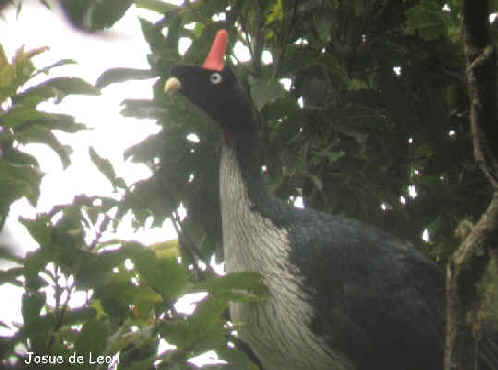
And again, during this tour, as during others in Guatemala previously, at the Mayan ruins of Tikal, the Orange-breasted Falcon was seen at a temple.
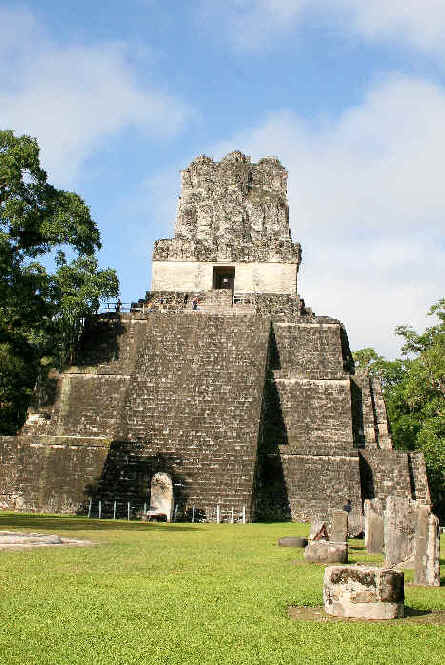
A Tikal temple
Links:
More about the FONT Guatemala
Tour in July 2007
Birds & Other Wildlife during our Guatemala Tour - July '07
![]()
GUATEMALA - December
2006 /January 2007 - Our Annual Holiday Tour in the "Highlands & Lowlands"
The following account was written by Armas Hill, leader of the tour:
Again, our annual holiday tour was in Guatemala, a great destination not just
for the festivities of the season, but also for a nice assortment of birds and
other nature. And certainly not to be ignored is that the weather during the
time of the tour was, as usual, about perfect.
Thus, there were the components
for an enjoyable tour, in each of the varied habitats that we visited, including
the marshes near the Pacific, the high mountain forests nestled between volcanic
peaks, and during our treks along rivers and forest trails by temples remaining
from a civilization that flourished over a thousand years ago. Collectively, we
found over 250 species of birds in these settings, where we also saw animals,
butterflies, and wonderful scenery, during this, the 13th FONT tour in
Guatemala.
Click links below to a fine collection of photographs taken during the tour, and
to lists of birds and other wildlife during both this tour and in Guatemala
cumulatively during all of our tours there. About 550 birds are now in the
cumulative list.
Links:
More about the FONT Guatemala Tour in Dec '06 / Jan '07
Photos of Nature & Scenery from our Guatemala Tour Dec '06/Jan '07
Newspaper Article about Dec '06/Jan '07 FONT Guatemala Tour
Birds & Other Wildlife during our Guatemala Tour - Dec '06/Jan '07
![]()
GUATEMALA - March
2006 in the "Highlands & Lowlands"
This was the 12th FONT tour in
Guatemala - it was in both the highlands and lowlands of the country.
It was
different than our other previous Guatemala tours in that during it there as
many as 6 boat-trips. They were in areas of coastal mangroves & marshes and
along an inland river away from civilization and small clear-watered rivers
filled with little fish flowing into a large lake. Conducting so many boat trips
was certainly productive as among the many birds seen there were: Pinnated
Bittern, Agami Heron, Boat-billed Herons, and hundreds of Wood Storks
and American White Pelicans. During one day from a boat, all 5 species of
North American kingfishers were seen.
There were also avian highlights
away from water. In the area of the Mayan ruins at Tikal, an Orange-breasted
Falcon was by a temple, and a Pheasant Cuckoo was seen and heard
doing its odd display on the ground.
Links:
More about the FONT Guatemala Tour in March 2006
List
of Birds during our Guatemala Tour - March '06
![]()
GUATEMALA - December
2005 / January 2006, Our Holiday Tour in the "Highlands & Lowlands"
This tour, in the highlands
& lowlands of Guatemala, was at a wonderful time of year to be there. A
couple months earlier, in Oct 05, particularly in the highlands, there had been
some destruction due to severe weather (Hurricane Stan).
But during our tour the
weather could not have been better. And the birds were fine too.
In the
highlands, among the best were the adult male Sparkling-tailed Woodstar,
the Prevost's Ground Sparrow, and the Pink-headed Warbler, a
perennial favorite.
In the area of the Mayan ruins of Tikal, birds
ranged from the large, such as the Great Curassow (great looks!),
to the small & colorful, such as the Manakins. The males of the White-collared
& the Red-capped were favorites.
Links:
More
about the FONT Holiday Tour in Guatemala in December 2005/January 2006
List of Birds during our Guatemala Holiday Tour - December '05-January '06
Cumulative list of Birds during our previous Guatemala Tours
Upcoming
FONT Birding & Nature Tours in Guatemala
To
Top of Page
![]()
GUATEMALA
- March/April
2005, in the "Highlands & Lowlands"
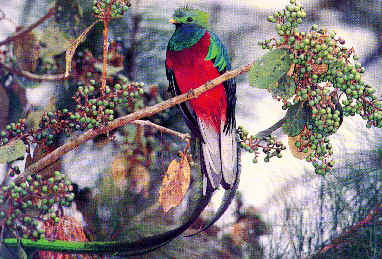
Resplendent Quetzal
Here's
the list of our "top birds" during the March-April 2005 FONT birding
tour in Guatemala, as voted by the participants:
1 - RESPLENDENT
QUETZAL
2 - Garnet-throated
Hummingbird
3 - Lesser Roadrunner
4 - Great Curassow
5 - Pink-headed Warbler
6 - Prevost's Ground-Sparrow
7 - Northern Bentbill
8 - Chestnut-sided Shrike-Vireo
9 - Crescent-chested Warbler
10 - Black-vented Oriole
11 - Purple-crowned Fairy
12 - Orange-breasted Falcon
13 - Fan-tailed Warbler
14 - Hooded Grosbeak
15 - Ocellated Turkey
Birds during FONT March/April '05 Guatemala Tour
Birds & Other Wildlife
found during our Guatemala Tours (with photos)
Upcoming FONT Birding & Nature
Tours in Guatemala
![]()
GUATEMALA - December
2003/January 2004 Our Annual Holiday in the "Highlands & Lowlands"
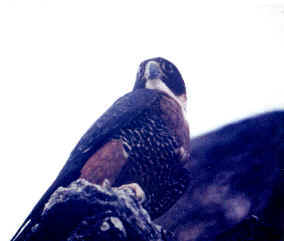
A pair of Orange-breasted
Falcons (one in the photo above) were seen again during our '03-04
Guatemala Holiday Tour, at a temple at the Mayan
ruins of Tikal. This was the 3rd FONT Guatemala tour during which the
species has been seen, once previously also in January, and another time in
April.
Other notable birds at Tikal included a Pheasant Cuckoo (seen on the
ground just a few feet from us) and a Black Hawk-Eagle (perched in
a tree outside the front door of our room).
The Resplendent Quetzal, one of the most beautiful of world's birds and
the national symbol of Guatemala, was also seen well during our tour.
"TOP 10 BIRDS" during our recent 2003-04 Holiday Birding Tour
in Guatemala
1. Orange-breasted Falcon
2. Pheasant Cuckoo
3. Resplendent Quetzal
4. Pink-headed Warbler
5. Ocellated Turkey
6. Black Hawk-Eagle
7. Sungrebe
8. Prevostís Ground-Sparrow
9. Crimson-collared Tanager
10. Gray-headed Piprites
Over 300 species of birds have
been seen during our Guatemala Holiday Tour. And other wildlife too, in a
beautiful and culturally interesting country. We'll be going again next year.
Birds during FONT Dec '03 - Jan '04 Guatemala Tour
Birds & Other Wildlife
found during our Guatemala Tours (with photos)
Upcoming Birding & Nature Tours
in Guatemala
![]()
GUATEMALA - April 2002, in the "Highlands & Lowlands"
The following account written by Armas Hill, leader of
the tour.
This tour took place April 10-22, 2002.
During our Guatemala birding tour
in 2002 prior to that, in January, we had the good fortune to see a pair of Orange-breasted
Falcons at Temple 4 in the Mayan ruins at Tikal.
Years ago in the 1980's, at
Tikal there was a pair of Orange-breasted Falcons. Then for years there were
none. Traditionally at Tikal, Orange-breasted Falcons established their eyries
in January (at the end of the rainy season) and laid 2 or 3 eggs in March
(during the dry season). And so, as hoped, the pair of Orange-breasted Falcons
was still at Temple 4 when we returned to Tikal in April.
Both birds of the pair were seen: the female above us on a ledge, and later
flying into a cavity near the top of the temple, and a male perched not far away
on a treetop.
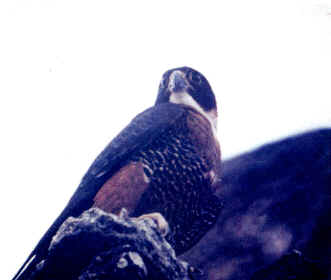
Orange-breasted
Falcon
Seen on Tikal temple
during 2 FONT tours in 2002
in Guatemala.
Earlier that same day, as we were entering the set of Tikal ruins known as
Complex 2, a large bird was seen overhead, doing a steady, straight flight
directly above us. The large bird was another rarely-seen raptor, a Crested
Eagle. Rather similar to the Harpy Eagle, both species (the Crested and the
Harpy) are only infrequently seen in their large ranges. Formerly the Crested
Eagle was said to occur from Honduras to Brazil, but there have been relatively
recent breeding records for the species in northern Guatemala and nearby Belize.
The bird that we saw at Tikal was a pale adult (much like 213ax on plate 72 in
the new "Raptors of the World" by Ferguson-Lees and Christie, but
slightly darker). There are intermediates between the pale and dark morphs.
Much smaller birds that we saw at Tikal included colorful White-collared
Manakin performing at its lek, and a group of bright Blue Buntings
parading about low in the forest.
The previous day was another good one for us, about a hundred kilometers south
of Tikal, by the Lake (Laguna) Petexbatun. It's a remote place, with no nearby
present-day towns, but not far from another Mayan settlement of the past known
as Aguacate. We spent the previous night in some very nice cabins on a forested
peninsula just above the shore of the lake. During the darkness of the night,
just outside our windows, the Howler Monkeys were loud. Early in the
morning, there were the more plaintive calls of tinamous. At daybreak on
the lake below, there was a Sungrebe. In the sky, a large flock of Black-bellied
Whistling-Ducks flew by, whistling as they went. Flocks after flocks flew by
of cormorants, all seen to be Neotropic. Two years ago we saw a
single American White Pelican. Also, that year, a single gull - not
Laughing as more commonly seen in Guatemala, but an adult Franklin's Gull.
This year, in April 2002, we once again saw
a single gull, an adult Franklin's, with its white primary tips.
The clean water of Lake Petexbatun were certainly filled with fish, as there
were so many piscivorous birds. In addition to the cormorants, there were
numerous egrets and herons. Osprey were flying above,
periodically going to the water's surface for a fish. We saw 5 species of
kingfishers in the area, including the smallest, the Pygmy, and a
late Belted. We were piscivorous as well, having for a lunch at the
lodge, tasty "white fish" from the lake.
In the morning that day, we experienced some of the highlights of the tour. The
morning began with a red-orange sun rising over the eastern shoreline of the
lake. That color was an omen of something we saw about two hours later. Low
(about eye-level) in brushy vegetation in the forest, a bright red-orange object
was moving back-and-forth. In binoculars, it was clearly seen to be the erect
crest of the male Royal Flycatcher. For 5 minutes we stood still as we
watched the bird sidestep, a dance, a display, in front of an onlooking female.
The crest stayed erect the entire time. What a fantastic sight in Guatemala in
April!
Nearby, on the leaf-covered ground, a Mexican Antthrush also stayed as we
stood still those 5 minutes. The antthrush was probing under the leaves,
and tamely walking about, oblivious to us.
Also tame on a low tree trunk by us was an Ivory-billed Woodcreeper, also
acting rather oblivious to us as it probed for food under the bark. That bird
can be said to be known by two names: Ivory-billed Woodcreeper when seen, and
Laughing Woodcreeper when
heard!
Our "good birding" in Guatemala was not restricted to the lowlands.
When we were in the volcanic highlands, we saw, in pine-oak forest, a pair
of uncommonly-seen Hooded Grosbeaks with nesting material,
not far from a territorial pair of Gray Silky-Flycatchers. Our experience
with the attractive Pink-headed Warbler, indigenous to that part of the
world, was superb. Also great to see were dapper Prevost's Ground-Sparrows
and Blue-and-white Mockingbirds. Perhaps the best was a tremendous look
at a beautiful Spotted Nightingale-Thrush as it stood still, in front of
us, on the forest floor of the cloud forest reserve inhabited by the Resplendent
Quetzal, Emerald Toucanet, and Blue-crowned Chlorophonia. Even in the depth of
the woods, the Spotted Nightingale-Thrush was also a colorful splash of yellow,
orange, black, olive, and gray.
Guatemala in April is a great place for bird migration, and we certainly had
some wonderful experiences relating to the phenomenon.
By Lake Atitlan, one of the most beautiful
places on earth, one morning, in the sky over the town of Panajachel,
where we stayed, there were, as we arose, many Swainson's Hawks, arising
as well. There were kettles of them overhead, along with smatterings of Broad-winged
Hawks and Turkey Vultures. Thousands of these birds were in the sky.
Elsewhere in the highlands, in Verapaz, one morning there was a treeful of
brightly-colored male Blackburnian Warblers. Across the road, another
tree was laden with Blue-headed Vireos on their way north. Further down
the road, we encountered a group of about a dozen Gray-cheeked Thrushes
that had probably alit after a nocturnal flight. These thrushes were
particularly interesting as they were seen, close to ground, catching insects.
At least twice, one thrush was seen feeding a freshly-caught bug to another.
Pairs seemed to be formed well before these long-distance migrants arrive on
their breeding grounds in the far-north of Canada and Alaska.
Migration was throughout the country, from the arid desert of the east, where
flocks of Cliff Swallows flew about, consuming their diet of insects in
the late-afternoon sky, to the mangrove-edged channels of the Pacific Coast
where a flock of Pectoral Sandpipers was resting (probably on its way to
Alaska), a flock of Caspian Terns was feeding, and 2 Black Skimmers flew
by (in the "Birds of Guatemala", published in 1970, Hugh Land noted
that there had been no records of Black Skimmers in the country since 1903).
In all, we found well over 300 species of birds during our Guatemala tour in
April 2002. Our cumulative list of birds
found in the country increased to 512
species.
The "Top Birds" as voted by
participants after the tour were:
1 - Orange-breasted Falcon
2 - Pink-headed Warbler
3 - Royal Flycatcher
4 - Crested Eagle
5 - Hooded Grosbeak
6 - Mexican Antthrush
7 - Prevost's Ground-Sparrow
8 - Gray Hawk
9 - American Pygmy Kingfisher
10 - Spotted Nightingale-Thrush
Upcoming FONT Birdng & Nature Tours in Guatemala
![]()
GUATEMALA - December 2001 / January 2002 in the "Highlands & Lowlands"
with:
Ornate Hawk-Eagle
a pair of Orange-breasted Falcons
Pheasant Cuckoo
Resplendent Quetzal
Hummingbirds
and a number of other "good birds"
The following account written by Armas Hill, the leader
of the tour.
Our annual FONT Holiday Birding Tour, from December 26, 2001 to January 5, 2002,
was in
Guatemala.
During previous years, since 1990, our "holiday birding"
has been in Costa Rica (a few years), the Dominican Republic, southern Spain,
and Japan (to usher in the new millennium).
Now, here are some of the highlights (and there were some!) during our Holiday Tour 2001/02 in Guatemala:
We were at Tikal, in the Peten
region of Guatemala, on January 4, 2002. Early that morning, we were walking
around the edge of a small pond looking for a Bare-throated Tiger-Heron, when to
our surprise, there was an adult Ornate Hawk-Eagle perched in a small
tree, no higher than 15 feet from the ground, and no more than 25 feet from us!
It stayed there as we watched it, for over a moment, before flying into the
higher canopy in the nearby forest, where it caused a loud raucous by Brown
Jays.
But that was not to be our only spectacular raptor sighting that day:
On an upper ledge
of Temple 4 (in the photo below), the highest of the Mayan temples at Tikal, an Orange-breasted
Falcon was perched. The bird's nearly the size of a Peregrine. The species
is quite a rarity, occurring spottily in parts of Central and South America.
It's a bird rarely encountered. But we were fortunate to see not only one, but
two of them, a pair, on the temple, and in flight. We also listened to them
calling to each other.
When we climbed the high temple,
one of the two Orange-breasted Falcons 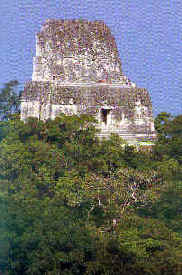 was sitting on a branch in a tall tree by the temple. We saw it at eye-level, as
the other bird was above us on a ledge. The eye-level bird in the tree was
close, about 40 feet away, with sunlight shining on its bright orange breast.
was sitting on a branch in a tall tree by the temple. We saw it at eye-level, as
the other bird was above us on a ledge. The eye-level bird in the tree was
close, about 40 feet away, with sunlight shining on its bright orange breast.
Years ago, the rare Orange-breasted Falcon and the common Bat Falcon both
occurred on the tall temples at Tikal, above the surrounding jungle. But in
recent years, the Orange-breasted Falcon has not been there. It was such a treat
that 2 Orange-breasted Falcons were there for us in January 2002.
Another treat we experienced at Tikal, the previous day, was an observation rarely had of a Pheasant Cuckoo. As we were walking along what was the old airfield, we heard, low to ground, in the dense brush, an odd sound. It was a bit like an electric motor. When we peered into the understory, we saw, very near to us on the leaf-covered ground, a brown-and-white jay-sized bird, walking about. It had a long and fanned-out tail. Its wings, lowered to the ground, were vibrating. We stood very still. The bird stayed. We watched it move about, slowly but erratically, with the continuous buzzing sound. Then, the Pheasant Cuckoo drifted away into the underbrush, and we left, wondering how many people have ever witnessed what we had just seen.
There was more, during our tour partly in 2001, and then into the new year:
We can truly say that the Year 2002 began for us, resplendently. Early in the morning, on January 1st, we were looking at 3 Resplendent Quetzals. We saw them both perched in trees and flying about, with their "long tails" dangling behind them. More than once, the 3 males flew from tree to tree, one after the other. When they were perched, we had wonderful looks at them in a telescope. As they were not far away, they were "full-frame" in the scope.
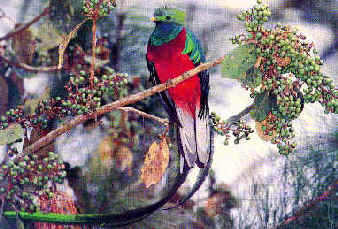
We were in the cloud forest, but
the sun was shining, that first morning of the year. The Resplendent Quetzal is
considered among the most spectacular of the world's birds. The male appears to
have a very long tail (actually it has 4 upper tail-coverts elongated into
slender streamers). In the sunlight, we saw the brilliant iridescent colors and
hues of green, red, gold, and blue.
The Resplendent Quetzal is the national emblem of Guatemala. It's the national
bird, and the name of the currency. As we traveled about, we also saw it as
names of a bank and a chain of nationwide gas stations.
During that January 1st morning, in the trees around the quetzals, there were other fruit-eating birds, including the Highland Guan, Emerald Toucanet, and Azure-hooded Jay.
Singing in the background, was the Slate-colored Solitaire. As we were watching one of the world's most beautiful birds, the Quetzal, we were hearing one of the world's most beautiful songs, of the solitaire.
Other birds during the tour ranged from as large as pelicans and turkeys, to as small as hummingbirds:
When we were watching the
Orange-breasted Falcon atop a Tikal temple, a line of about a dozen Brown
Pelicans flew overhead. Brown Pelicans are not to be expected in the sky
there above the Peten jungle. The seacoast is far away. But some pelicans can
occur rarely at the large lake, Lago Peten Itza, about 60 kilometers west of
Tikal.
During a previous FONT tour, in the Peten, the other American pelican, also a
rarity in the region, was seen. A single White Pelican was on a sandbar in a
river, the Rio de la Pasion.
On the ground at Tikal, during our just-completed tour, one afternoon, 10 Great Curassows were seen, both black males and brown females. But probably that afternoon also, 10 times that many Ocellated Turkeys were seen, doing the same, walking on the ground, and then going into trees at the day's end to roost. The turkeys, with quite an array of colors in their plumage.
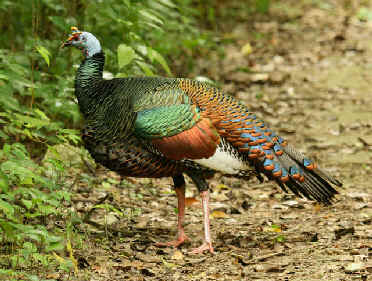
All hummingbirds are
small, some smaller than others. We observed a small one, the Little Hermit,
in the Tikal jungle, coming to a puddle to bathe. That species was one of 20
seen during the tour.
The smallest was the minute Emerald-chinned Hummingbird, just over 2.5
inches. The largest was the Magnificent Hummingbird.
Particularly enjoyable to watch were the male and female Sparkling-tailed
Hummingbirds at a wonderful flower garden by Lake Atitlan - a beautiful bird
at a beautiful place.
But there were other gems too including the Garnet-throated and Amethyst-throated
Hummingbirds, the Azure-crowned and Wine-throated Hummingbirds,
and the Slender Sheartail, just to name a few.
We visited a butterfly garden, also by Lake Atitlan. On the way in, we had a
fine encounter with another hummingbird, the Rufous Sabrewing.
Wedge-tailed Sabrewing, Purple-crowned Fairy, and Buff-bellied and
Rufous-tailed Hummingbirds were among the hummers we saw at Tikal.
In the highlands, one of the most conspicuous hummingbirds was the White-eared.
But also there were Ruby-throated, having journeyed, as we did, from
North America.
A few more of our encounters with birds in Guatemala are worth mentioning:
In the forest at Tikal, our
paths crossed a few times with those of ants. And, at times, those ants had nice
accompaniments of birds.
At one such swarm, there were about 25 woodcreepers, Tawny-winged and Ruddy,
on or near the ground. They stayed, with their feast, as we stayed, watching
them along with Gray-headed Tanagers (that name doesn't say it all - gray
heads, yellow bodies).
At another swarm of ants, there was another mass of birds. Among them Scaly-throated
Leaftossers (3 seen on one stem at once), foliage-gleaners, ant-tanagers,
and warblers Golden-crowned and Kentucky (yes, Kentucky Warblers
at an ant swarm).
Another interesting observation
we had at Tikal, one afternoon, was of 2 Gray-necked Wood-Rails preening
each other - delicately.
By the same pond, earlier that morning, we saw a Ruddy Crake quickly
emerge from the reeds and then disappear back into them.
Before concluding, mention has
to be made of warblers during the tour. There were many. And what
splashes of color!
In the highland forests of pines and oaks, we saw all four of these species
rather similar Black-throated Green, Townsend's, Hermit, and Golden-cheeked.
We also saw Olive and Crescent-chested Warblers, Slate-throated
and Painted Redstarts, and a real splash, the Red-faced Warbler.
But special in that forest was the exquisite Pink-headed Warbler,
indigenous to that region.
At Tikal, there were other warblers - many of which migrated from eastern North
America, from Blue-winged and Worm-eating to Yellow-breasted
Chat.
Mention has already been made of the Kentucky, but the Hooded must also
be noted. How dapper these colorful yellow-and-black birds are in the forest! On
a small slope, we watched 3 males continuously chase each other, up and down the
slope.
Another time, as a couple of us sat for a rest on a log, 2 male Hooded Warblers
lit next to us, just feet away, before circling around us. Birds that we
"go to see" in North America, coming to see us!
THE "TOP BIRDS" OF THE DEC 01/JAN 02
GUATEMALA TOUR
as voted by participants at the tour's end:
Each participant voted for 7 birds.
Each bird 1 to 7 worth two points less, thus 14 to 2 points.
Tied birds in taxonomic order.
A 3-way tie for First Place:
1 - Orange-breasted
Falcon 36
1 - Pheasant Cuckoo 36
1 - Resplendent Quetzal 36
Not far behind:
2 - Ornate Hawk-Eagle
30
The rest:
3 - Sparkling-tailed
Hummingbird 18
4 - Blue-crowned Motmot 12
5 - Ocellated Turkey 10
6 - Tody Motmot 8
7 - Red-capped Manakin 8
8 - Keel-billed Toucan 6
9 - Pink-headed Warbler 6
10 - Gray-necked Wood-Rail 4
11 - Collared Aracari 4
12 - Bare-throated Tiger-Heron 2
13 - Rufous-tailed Jacamar 2
14 - Hooded Warbler 2
17 species received votes. Only one species received votes by everyone; that was
number #2 bird, the Ornate Hawk-Eagle.
Cumulative List of Birds during FONT Guatemala Tours (with photos)
Upcoming FONT Birding & Nature Tours in Central America
The following came by letter to FONT from Dec/Jan 01/02 Guatemala tour
participants after the tour:
From Elaine & Patrick Nye, of Guilford, Connecticut, USA: